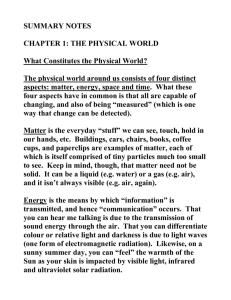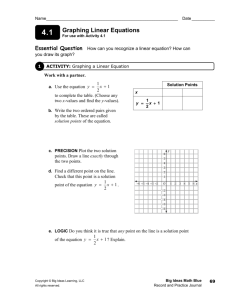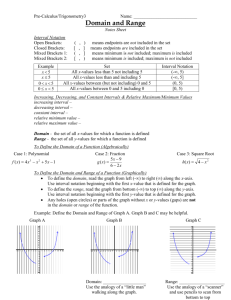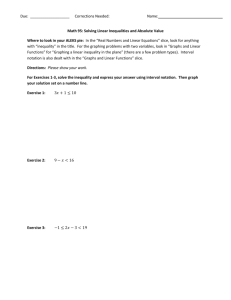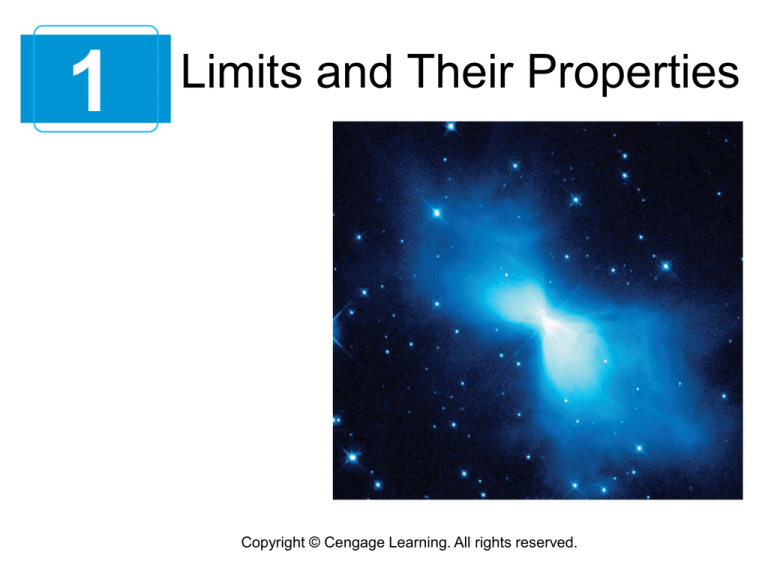
1
Limits and Their Properties
Copyright © Cengage Learning. All rights reserved.
1.2
Finding Limits Graphically
and Numerically
Copyright © Cengage Learning. All rights reserved.
Objectives
Estimate a limit using a numerical or
graphical approach.
Learn different ways that a limit can fail to
exist.
Study and use a formal definition of limit.
3
An Introduction to Limits
4
An Introduction to Limits
Suppose you are asked to sketch the graph of the function
f given by
For all values other than x = 1, you can use standard
curve-sketching techniques.
However, at x = 1, it is not clear what to expect.
5
An Introduction to Limits
To get an idea of the behavior of the graph of f near x = 1,
you can use two sets of x-values–one set that approaches
1 from the left and one set that approaches 1 from the right,
as shown in the table.
6
An Introduction to Limits
The graph of f is a parabola that
has a gap at the point (1, 3), as
shown in the Figure 1.5.
Although x can not equal 1, you
can move arbitrarily close to 1,
and as a result f(x) moves
arbitrarily close to 3.
Using limit notation, you can write
Figure 1.5
This is read as “the limit of f(x) as x approaches 1 is 3.”
7
An Introduction to Limits
This discussion leads to an informal definition of limit.
If f(x) becomes arbitrarily close to a single number L as x
approaches c from either side, the limit of f(x), as x
approaches c, is L.
This limit is written as
8
Example 1 – Estimating a Limit Numerically
Evaluate the function
at several
points near x = 0 and use the results to estimate the limit
9
Example 1 – Solution
The table lists the values of f(x) for several x-values near 0.
10
Example 1 – Solution
cont’d
From the results shown in the table, you can estimate the
limit to be 2.
This limit is reinforced by the graph of f (see Figure 1.6.)
Figure 1.6
11
Limits That Fail to Exist
12
Example 3 – Behavior That Differs from the Right and from the Left
Show that the limit
does not exist.
Solution:
Consider the graph of the function
. From
Figure 1.8 and the definition of absolute value
you can see that
Figure 1.8
13
Example 3 – Solution
cont’d
This means that no matter how close x gets to 0, there
will be both positive and negative x-values that yield
f(x) = 1 or f(x) = –1.
Specifically, if (the lowercase Greek letter delta) is a
positive number, then for x-values satisfying the inequality
0 < |x | < , you can classify the values of |x |/x as
follows.
14
Example 3 – Solution
cont’d
Because |x |/x approaches a different number from the
right side of 0 than it approaches from the left side, the
limit
does not exist.
15
Limits That Fail to Exist
16
A Formal Definition of Limit
17
A Formal Definition of Limit
Let’s take another look at the informal definition of limit. If
f(x) becomes arbitrarily close to a single number L as x
approaches c from either side, then the limit of f(x) as x
approaches c is L, is written as
At first glance, this definition looks fairly technical. Even so,
it is informal because exact meanings have not yet been
given to the two phrases
“f(x) becomes arbitrarily close to L”
and
“x approaches c.”
18
An Aside
The Box Game
• We choose some point on a graph (x, L)
• You choose a height of a box
(call it the error)
• I choose a width to meet that height
(call it the control)
• The game is for you to find a height that I can’t
match with a width where the function stays
inside the box.
• In the game, I continue until you give up or I
lose.
19
A Formal Definition of Limit
The first person to assign mathematically rigorous
meanings to these two phrases was Augustin-Louis
Cauchy. His
definition of limit is the standard used
today.
In Figure 1.12, let (the lower case
Greek letter epsilon) represent
a (small) positive number.
Then the phrase “f(x) becomes
arbitrarily close to L” means that
f(x) lies in the interval (L – , L +
).
Figure 1.12
20
A Formal Definition of Limit
Using absolute value, you can write this as
Similarly, the phrase “x approaches c” means that there
exists a positive number such that x lies in either the
interval
or the interval
This fact can be concisely expressed by the double
inequality
21
A Formal Definition of Limit
The first inequality
expresses the fact that
says that x is within a distance
The second inequality
of c.
22
A Formal Definition of Limit
23
Example 6 – Finding a for a Given
Given the limit
find such that
whenever
Solution:
In this problem, you are working with a given value of
–namely, = 0.01.
To find an appropriate , notice that
24
Example 6 – Solution
Because the inequality
to
you can choose
cont’d
is equivalent
This choice works because
implies that
as shown in Figure 1.13.
Figure 1.13
25




